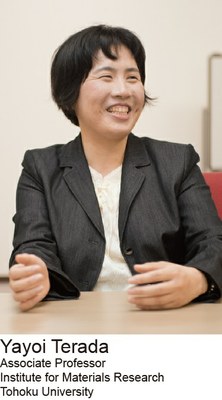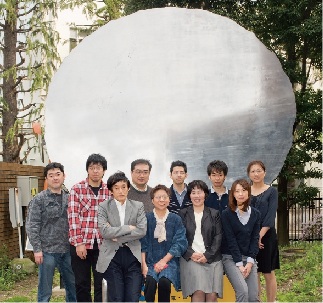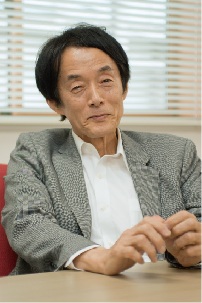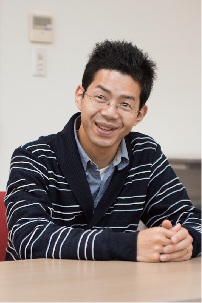Divisions of CMSI: CMSI Materials Science Division [Institute for Materials Research, Tohoku University]
 In this issue, Torrent features a new section introducing each of the CMSI Divisions and the supercomputer center in those divisions. For this first installment, we will take a look at the Computational Materials Research Initiative and the Center for Computational Materials Science, which is in charge of the operation and maintenance of the supercomputing systems installed at the Institute for Materials Research. Our guide will be CMSI Associate Professor Yayoi Terada.
In this issue, Torrent features a new section introducing each of the CMSI Divisions and the supercomputer center in those divisions. For this first installment, we will take a look at the Computational Materials Research Initiative and the Center for Computational Materials Science, which is in charge of the operation and maintenance of the supercomputing systems installed at the Institute for Materials Research. Our guide will be CMSI Associate Professor Yayoi Terada.
Division Established within the Historic Institute for Materials Research
The Computational Materials Research Initiative (CMRI) is located within the Institute for Materials Research at Tohoku University. The Institute for Materials Research (IMR) was founded nearly 100 years ago, in 1916, as the 2nd Division of the Provisional Institute of Physics and Chemistry Research of Tohoku Imperial University. As is well known, its first director was Kotaro Honda, who invented KS (magnetic) steel. The Institute has produced many research achievements, primarily in the field of metals and alloys. Currently we have been expanding our target to a wide range of substances and materials, from basic properties to application, with the aim of creating new materials that will be useful to society.
In 1993, the IMR introduced a supercomputer that began operating in 1994. Since that time, it has been very active as a research center for materials science by means of large-scale simulations and numerical calculations using computers ̶ said to be the "third" major research technique in addition to experimental and theoretical studies. Under the Computational Materials Science Initiative (CMSI) established in 2010, the CMRI was set up at the IMR in 2011 to be in charge of promoting fields relating to computational materials science, development of research, training of personnel and so on. 20% of the resources of the supercomputer (which was just upgraded in April of last year) at the Center for Computational Materials Science in the IMR are provided within the CMSI framework, and since November of last year reciprocal access from other Divisions has also become available.
I was appointed in January of this year to be an Associate Professor, the IMR in charge of the CMRI personnel training and education. In April, the CMRI Division Project Leader Tetsuo Mohri assumed the position of Head of the Center for Computational Materials Science. In this way, the Division structure of CMRI is gradually taking shape.
|
"Listen to the Voices of Users and Work to Make Supercomputers More User-Friendly"
The technical staff members who operate the supercomputer play an important role in supporting the diverse activities of the CMRI. We spoke to Nobuaki Igarashi, who has worked at the Center for Computational Materials Science for 13 years, and who assists users by giving advice on program and job execution and so on. We asked him to talk briefly about the Center, the rewarding aspects of his work and so on.
|
|
Nobuyuki IgarashiI majored in computer systems science at the University of Aizu and received my Master's degree from that university. I visited several departments within Tohoku University during job hunting and I chose this office, where the supercomputer was scheduled to be upgraded in February 2001. Starting from this fiscal year, I've been working as the coordinator of the supercomputer system. I'm very aware of the important responsibility with which I have been entrusted. |
"The Center for Computational Materials Science is a Collaboration Research Center that provides various services for more than 100 users per year. In the last fiscal year, 36 of those users were from overseas, so it is quite an international environment.
The Center provides a lot of applications software including freeware in order to respond to diverse requests from users. We also support the installation of freeware upon the request. This way, we are well prepared to provide versatile software services and technical supports to our users, and supercomputer becomes more user-friendly. Since supercomputers are also evolving on a daily basis, we also upgrade the supercomputer every few years to enable it to always take on cutting-edge challenges. I feel great satisfaction in doing this.
Many of the users within the CMSI framework, who began use starting from the previous fiscal year, are engaged in large-scale computing with code that they have developed by themselves. So we increased the number of queues that use a large number of nodes and took other steps to make it easy for them to use the supercomputer. Since the most important thing is to enable people to produce research achievements using the supercomputer at our center, we want to encourage people to feel free to give us their opinions and requests. Overseas users feel free to ask questions by email and so on. I think this kind of response from users will help to create a more user-friendly supercomputing system."
The Center for Computational Materials Science has five technicians (including Mr. Igarashi) and two resident system engineers (SE), all of whom are charged with the operation of the supercomputer. In my area of personnel training and education as well, the help of the technical staff is indispensable. In order for computational materials science researchers and engineers to be able to handle the K computer and future supercomputers, they need not only specialist knowledge in the fields of engineering and science but also computer science knowledge. In providing that type of education, I've been helped many times by the accumulated experience and knowledge of our technical staffs.
In this way, those of us who are engaged in the CMRI activities are supported by the technical staffs. At the CMRI, the technical staffs, the researchers, and the teaching staffs who provide next-generation personnel training and education will maintain close communication with one another while continuing to fulfill their respective roles, in order to achieve more well-developed activities.
 |
CMRI and Center for Computational Materials Science staffs: (From left to right in the back) Kazuhiro Satoh (technician), Taiga Ohtaki (technician), Hiroshi Mizuseki (concurrent Associate Professor), Nobuaki Igarashi (technician), Kohta Tanno (technician), and Akie Kato. (From left to right in the front) Tetsuo Mohri (CMRI Division Project Leader), Kyoko Ichinoseki (technician), Yayoi Terada (concurrent position) and Nozomi Kadowaki. The background of the photograph is a cross-sectional test specimen of the 400-ton Mn-Mo-Ni low-alloy steel ingot fabricated in 1969 by Japan Steel Works, Ltd., at the time the world's largest, which was donated by the Metals Museum. |

 Message from Tetsuo Mohri,
Message from Tetsuo Mohri,
